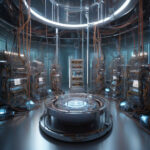NASA’s Plan to Deploy 100-Kilowatt Nuclear Reactor on Moon: A Strategic Move to Outpace China and Russia
Interim NASA chief Sean Duffy, who also serves as US Transportation Secretary, will reveal a groundbreaking plan that could potentially revolutionize space exploration as we know it. NASA is considering deploying a 100-kilowatt nuclear reactor on the Moon, a move strategically aimed at outpacing major space players like China and Russia.
The prospect of a nuclear reactor on the Moon is not merely a futuristic concept but a tangible project that could soon become a reality. This innovative approach to power generation in space could provide a sustainable and reliable source of energy for future lunar missions, setting a new standard for deep space exploration.
The deployment of a 100-kilowatt nuclear reactor on the Moon holds immense significance for NASA’s ambitious plans to establish a sustainable human presence on our celestial neighbor. Unlike solar power, which is limited by the availability of sunlight, a nuclear reactor would provide a constant and abundant source of energy, essential for supporting long-duration missions and enabling activities such as mining, habitat construction, and scientific research.
Moreover, the strategic implications of such a move cannot be overstated. With China and Russia making significant strides in their space programs, including plans for crewed lunar missions, NASA’s deployment of a nuclear reactor on the Moon signals a clear intent to maintain its leadership in space exploration. By leveraging advanced technologies and innovative solutions, NASA aims to stay ahead in the space race and secure its position as a frontrunner in the quest for lunar exploration.
The use of nuclear power in space is not a new concept, as demonstrated by previous missions such as the Voyager spacecraft, which rely on radioisotope thermoelectric generators for power. However, the deployment of a nuclear reactor on the Moon would represent a major leap forward in terms of scale and capability, opening up a wide range of possibilities for future missions and activities on the lunar surface.
One of the key advantages of a nuclear reactor is its ability to provide high levels of power in a compact and efficient manner. The 100-kilowatt reactor under consideration by NASA could potentially generate enough electricity to power a small lunar base, paving the way for sustainable human habitation and exploration beyond Earth’s orbit.
In addition to its practical benefits, the deployment of a nuclear reactor on the Moon carries symbolic significance as well. It serves as a testament to human ingenuity and determination, showcasing our ability to overcome technological challenges and push the boundaries of exploration. By harnessing the power of nuclear energy in space, NASA is not only advancing the frontiers of science and engineering but also inspiring future generations to dream big and reach for the stars.
As NASA prepares to unveil its plans for the deployment of a 100-kilowatt nuclear reactor on the Moon, the world watches with anticipation and excitement. This bold and visionary initiative has the potential to reshape the future of space exploration and reaffirm America’s position as a global leader in science and technology. With innovation and determination as its driving forces, NASA is poised to write the next chapter in humanity’s journey to the stars.
NASA, Moon, Nuclear Reactor, Space Exploration, Innovation












